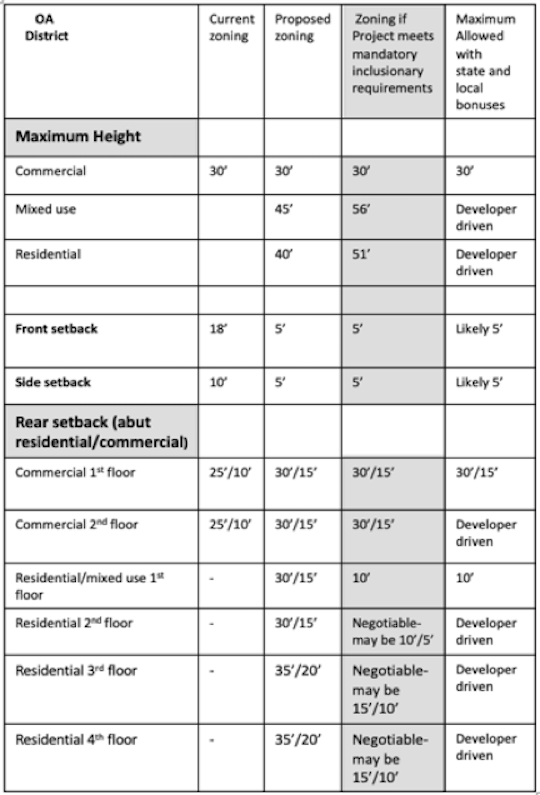As regards zoning changes that will affect every Los Altos resident
This is a letter to our City Council on the subject of making critical and impactful changes to our zoning laws which will have considerable permanent, long-term effects on Los Altos. It’s written as an Open Letter because of the importance to every resident in our community and to how much we should all be aware of what these changes will mean for our town.
Work in haste, repent at leisure. Don’t throw out the baby with the bathwater. The grass is always greener on the other side of the fence. There are these and many other expressions that urge caution when making change. Contrary to what some may proffer, these witticisms aren’t meant to stop change, but to ensure that responsible change occurs.
Council began updating the Housing Element Update by making changes to the zoning of various districts within the City . The effort began in late September and will continue with the upcoming Council meeting in November (and subsequent meetings up through January 31, 2024). The January date is a State-imposed, non-negotiable deadline to make changes that were part of the approved/adopted Housing Element.
No one likes that deadline, but it should not be used an excuse for making changes to our zoning that are not well thought out and will haunt all of us for decades to come. Silicon Valley has finally learned that the mantra should be move fast but DON’T break things. We need to heed that wisdom.
Zoning changes have already been made to the downtown (often abbreviated in “planning speak” as CD, CRS and CD-R3), commercial districts like Rancho and Homestead (CN zone) and the multifamily areas such as along Gabilan, Lassen, Tyndall, etc. (R3). Up next at the November 14th City Council meeting are the OA zone, which is primarily located along San Antonio Road and Altos Oaks Drive (and includes smaller areas on Distel Circle and in Loyola Corners), and the commercial thoroughfare zone (CT zone) which runs along El Camino Real.
While we will address here the changes that should be made to the OA district, many of these comments apply to the other zones as well. Furthermore, residents who do not live adjacent to commercial districts in town need to be keenly aware of the proposed zoning changes. Why? Because Los Altos, like essentially every city in the state, is unlikely to meet its 4-year housing target at the midpoint of the 8-year Housing element timeframe. The State law mandates that missing the target unleashes further draconian steps in the State legislation which will allow almost anything to be built anywhere in the City. And even if we do, by some miracle, meet the 8-year housing target, the next cycle will necessitate allowing large, multifamily construction in every neighborhood, perhaps next door to you or across the street from your house.
We want to specifically address the changes that should be made to the OA district (quick reminder—the OA district is along San Antonio and Altos Oaks), although there are many similar changes that should be applied to the CT zone as well.
- Minimize impact of new housing on adjacent single-family residences
- If the City Council is serious about putting housing in along San Antonio Road, then change the zoning to residential only (i.e., no commercial or mixed-use buildings) and make existing commercial use non-conforming. This would accelerate the development of residential housing and eliminate the possibility of mixed-use buildings, which staff and planning commission have recommended with a height limit greater than “residential only” development. Better for residential neighbors, more housing, a win-win.
- Do not allow balconies that face adjoining single family residential lots – they will have a direct negative impact on the privacy of surrounding single-family residences as all the properties directly abut residents side or backyards. This limitation was actually applied at 5150 El Camino, for example. So, codifying it for all projects in the OA district makes sense.
- Incentivize lower impact, townhouse-type units. At the January 10, 2023, meeting members of Council agreed that any development along San Antonio should be “consistent with and compatible with the surrounding single family residential neighborhoods”. There was talk about townhouse units that could provide needed housing while being of a height and scale compatible with the neighborhood. Unfortunately, at present, there is nothing in the zoning which encourages townhouses and disincentivizes overly tall, bulky, and out-of-scale buildings that are not compatible with the surrounding neighborhood and which are better suited for sites in the downtown.
- While we continue to support additional housing and more importantly affordable housing in the City, there needs to be a balance to ensure undue impact on surrounding neighbors. At that very same meeting in September that Council took up the rezoning of the CN and other districts, a resident was appealing a Planning Commission ruling on a new deck on their house that would have had little to no effect on the neighbor’s privacy. The appeal was denied as 3 of the council members (all of whom have coincidently been the most vocal advocates of adding housing with little regard to the impact on surrounding residents) voted against it, justifying their position that a variance for the deck setback would have undue impact on the neighbor and the neighborhood. We wish that same sensitivity permeated the discussions around where and how housing was added to areas that abut existing single family residential neighborhoods. It is puzzling that Council is seemingly willing to “protect” one neighbor deemed impacted from development but ignore larger scale development that impacts far more residents.
- Recognize and mitigate parking impacts
- Do a better job of planning for where the cars associated with the new housing will park. Our prior experience indicates that projects, that intentionally do not meet parking demand generated on site, will be under-parked by 20% or more. This translates into a need to park 25-30 cars at unknown, offsite locations if the City meets its target of 30 units per acre minimum at the 10 identified sites, encompassing 3.82 acres, are developed along San Antonio Road. The existing side streets along San Antonio are narrow and serve as the primary pathways for residents to get to the downtown; they cannot easily accommodate extra vehicles without creating a safety hazard for pedestrians, bicyclists and emergency vehicles.
- Be honest with the neighborhoods and overall community about heights, parking impacts and other impacts of state mandate which allow developers to exceed our zoning limitations. We remain disappointed that residents have not been given a detailed understanding of the changes that are being made to the zoning. Existing as well as proposed height limits and setbacks and the heights that will likely result from “benefits” under state law need to be clearly stated.
- Residents deserve to know that in almost every new development that is proposed, those projects will need to meet the 20% inclusionary affordable housing requirement and required densities – which in turn allows greater height, reduced setbacks, and less parking than specified in the nominal zoning. These are the consequences when development triggers numerous development incentives and waivers, from the City’s list of incentives and state mandated bonuses.
- Very simply stated, while we can talk about the OA district going from 30 feet height currently to “only” another 10 feet, to 40 feet total height, reality is far different. Every developer will take advantage of the additional 11-foot height increase available to them so projects will be more like 50’ tall. And while setback to existing single family residential lot is proposed to be 25 feet, a developer can and will ask for a reduction in that setback, claiming they cannot build the project otherwise.
- A further way to mitigate impact on adjacent neighborhoods is to prohibit roof-top amenities that have otherwise been allowed on El Camino and First Street so as to preclude further height and privacy issues for adjoining single-family homes.
- At the end of this document is our best assessment at what the proposed zoning changes really mean to the OA district. In some cases, a developer will get only some of the bonuses and incentives shown on the table. But it does serve to illustrate how the nominal zoning does not reflect what will actually be approved and built. As time permits, we expect to generate those for the other areas of town as well.
- Be honest about the impacts to date and the lack of affordable housing that has resulted from the changes to date in our zoning rules
- Our final point is that the City and community need to take a critical look at what the policies and rezoning to date have yielded. While we have had some new development, particularly along First street and El Camino, the truth is that there has been very little affordable housing built. In fact, most of the housing has been relatively high-priced condos. Even some of the ADU changes have yielded lackluster results; most of those units serve as guest houses for the residents or worse yet are just bonus space that a developer can add to the square footage of a house by using the junior ADU provision. (That provision in the State law allows adding space to a primary residence with the only requirement being the bedroom must have a separate entrance and bathroom. There is no need for separate cooking facilities.) We have seen multiple examples of developers using this loophole and the resulting houses are selling in the $5-6M range. The result is an ESCALATION in housing prices without any additional housing, giving lie to the State’s supposed intention. That loophole needs to be closed.
- The City staff and City Council need to do a better job of factoring in the impact of zoning changes on the residents. At the meeting to discuss zoning changes at Rancho (the CN zone), Council member Pete Dailey expressed his enthusiasm for bigger, more dense buildings, which would have even a greater impact on the immediately adjacent neighbors. While we appreciate the enthusiasm for additional housing, we wish he would factor in the negative impact of a taller building on the adjacent residents and find ways to keep projects modest in size for each developed site.
We do understand the urgency to meet the State-mandated deadline for zoning changes and we do support additional housing and more importantly affordable housing. But putting in flawed zoning rules with insufficient input from the public because they haven’t been adequately informed borders on irresponsible. We hope the City Council agrees and makes good changes for the benefit of the overall community, not just those who directly benefit from the rezoning effort.
What can you do?
- Write the city council and let them know how you feel about these zoning changes (email PublicComment@losaltosca.gov)
- Attend the council meeting on November 14th which starts at 7 pm.
- Forward this article to your neighbors.
And that’s the way we see it.
Friends of Los Altos Board of Directors:
Jonathan Baer
Lou Becker
Ron Packard
David Casas
Kenneth Lorell
– – –

– – –
